Fabrication and Simulation of Self-Focusing Field Emission X-ray Tubes
Abstract
:1. Introduction
2. Simulation Methodology, Material, and the Experiments
2.1. Finite Element Method (FEM)
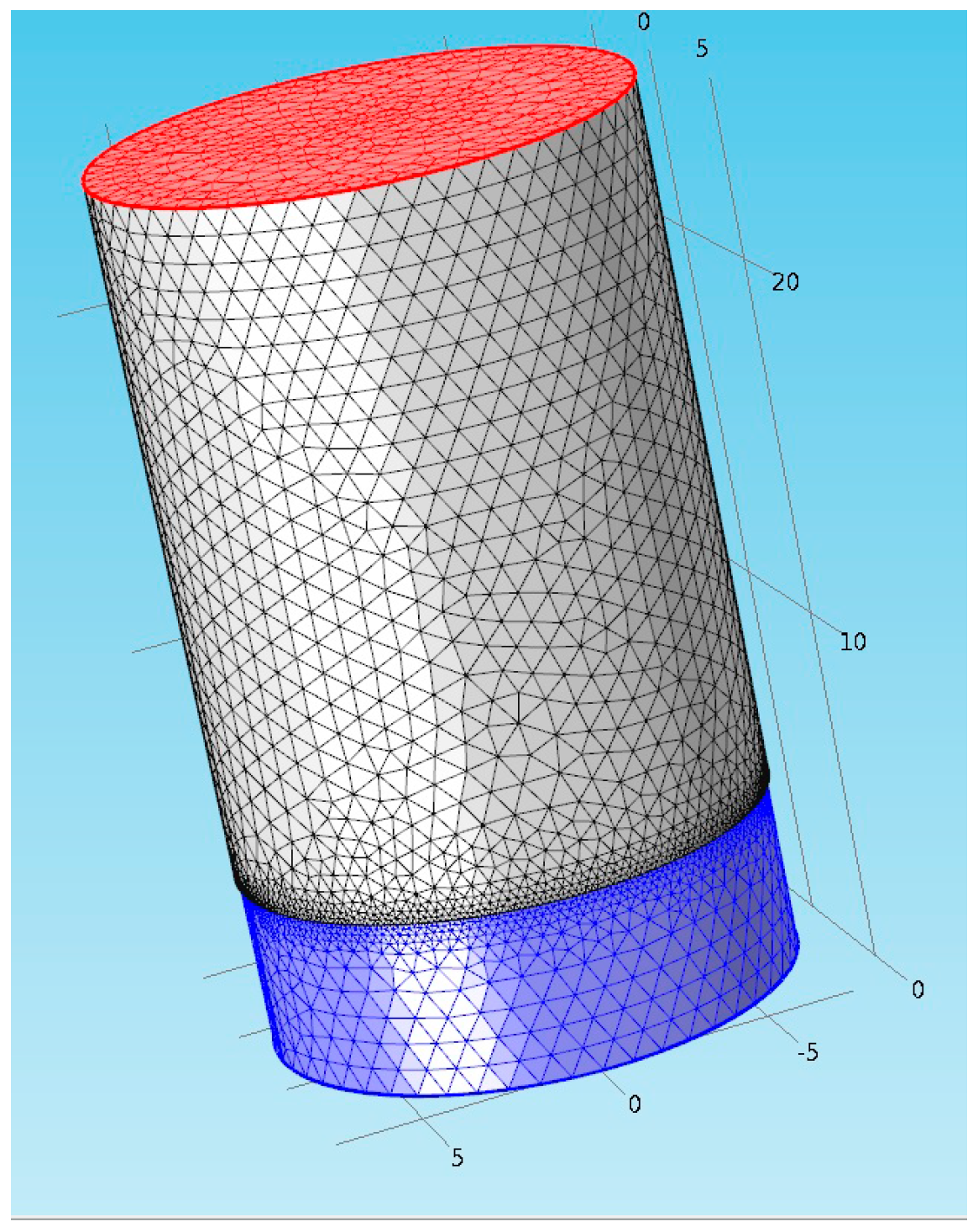
2.2. Field Emission Theory
2.3. CNCs as Electron Emitting Nanomaterial
3. Results and Discussion
3.1. Simulation of the Self-Focusing Cathode Design
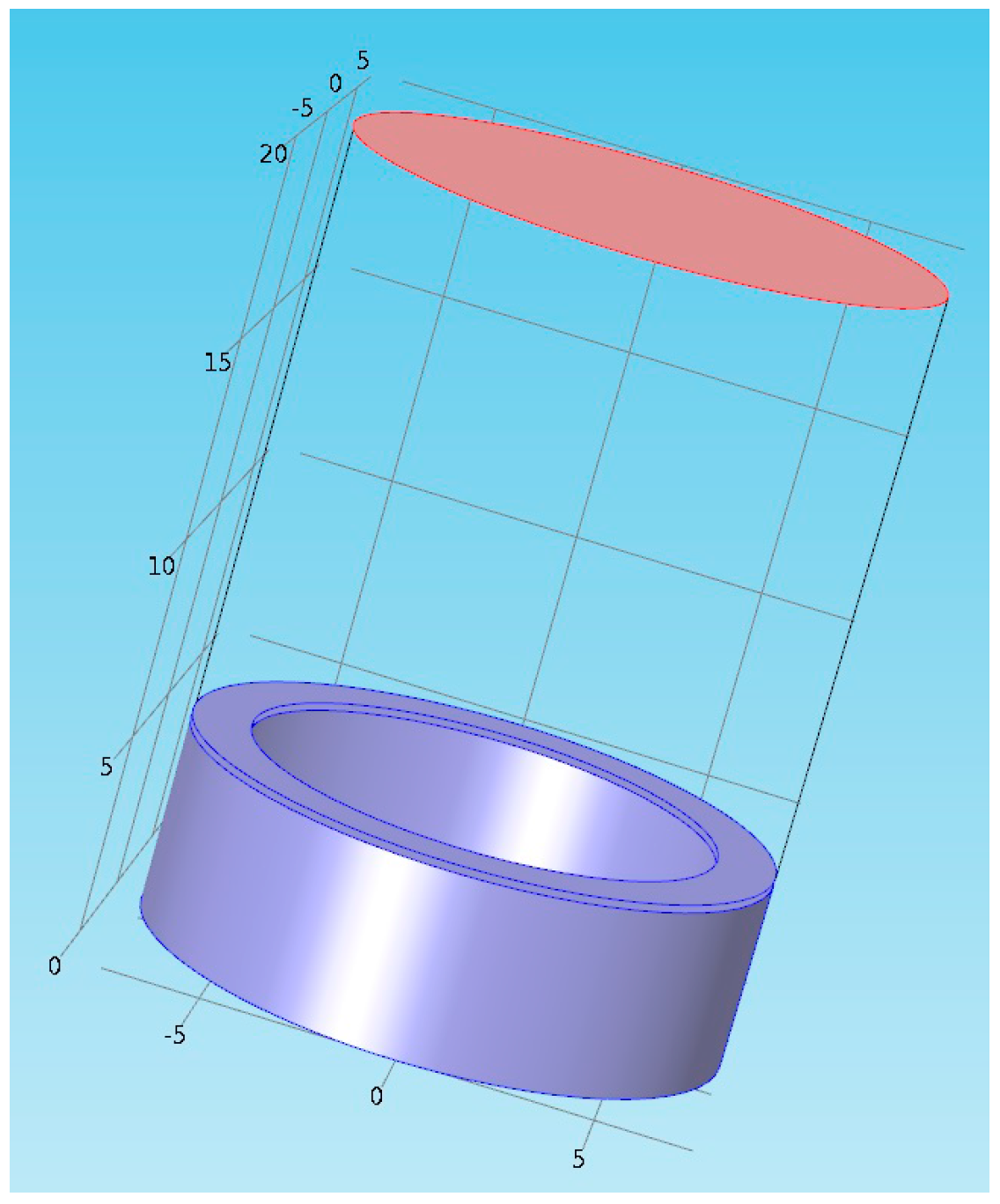
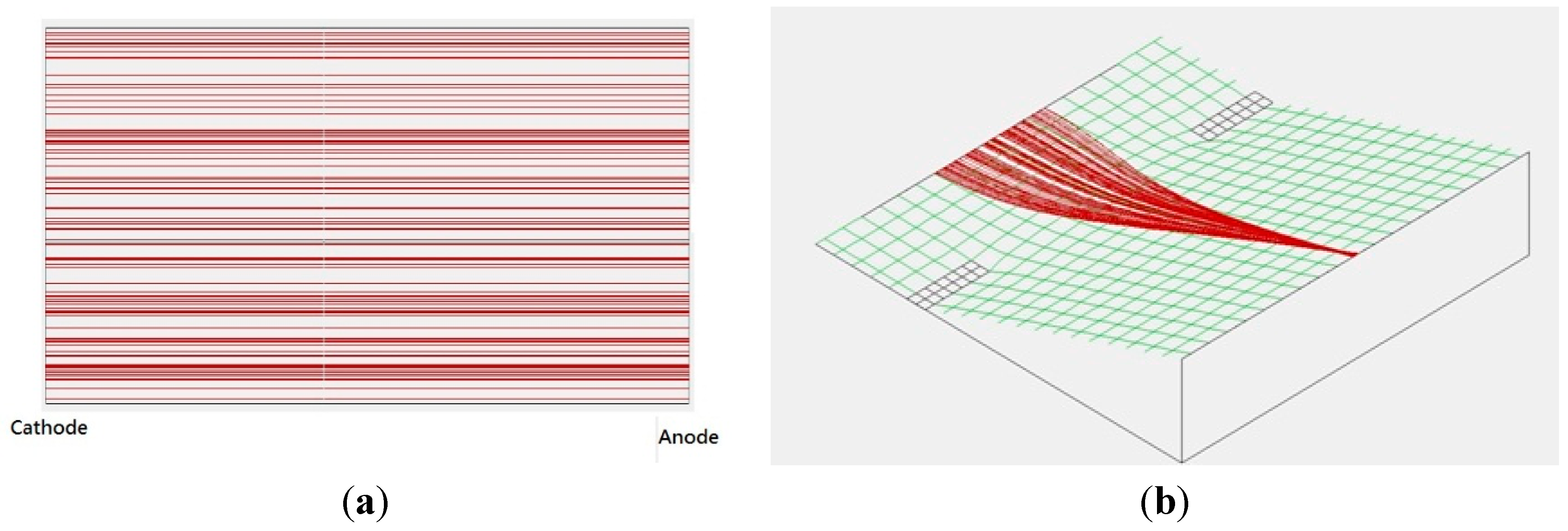
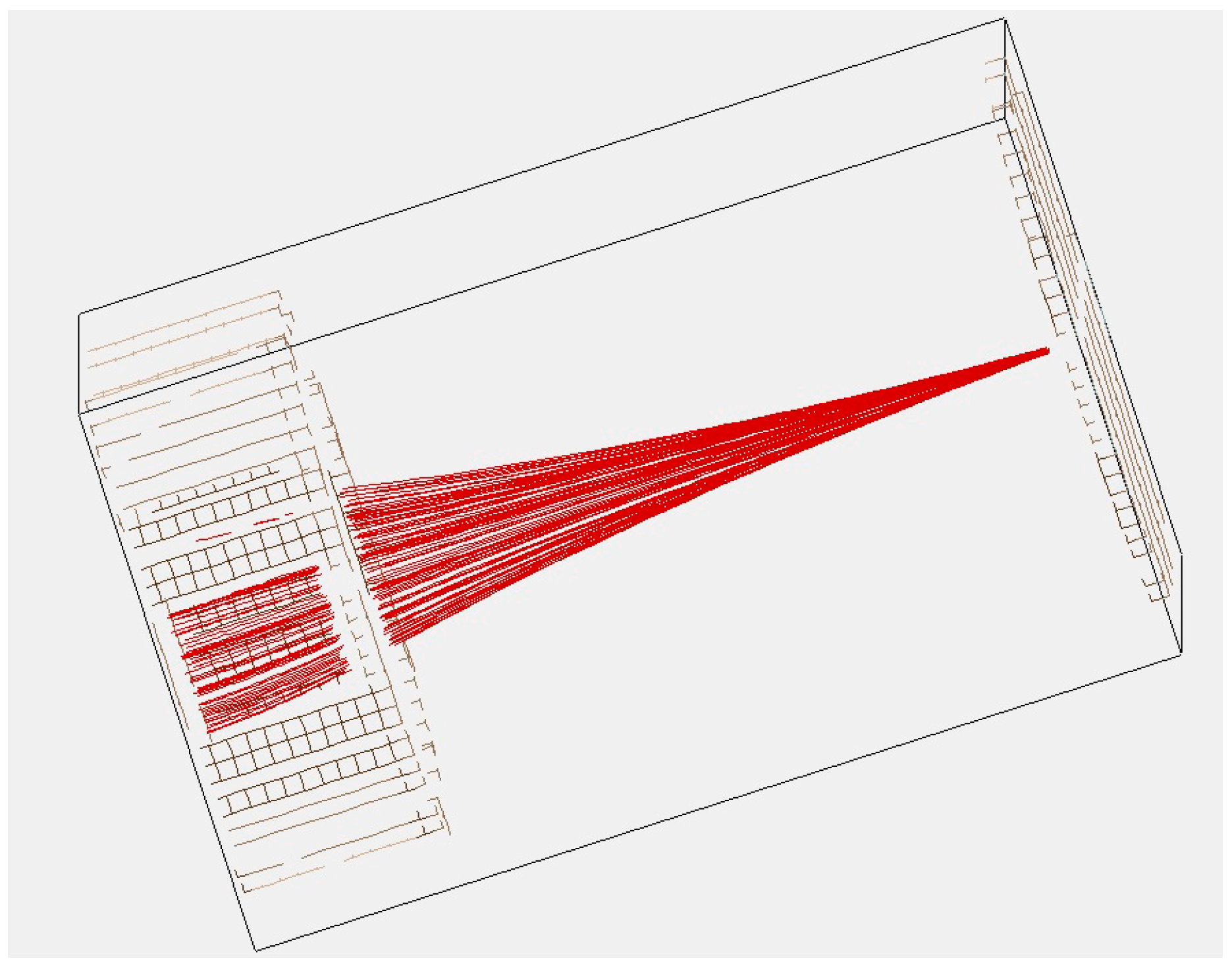
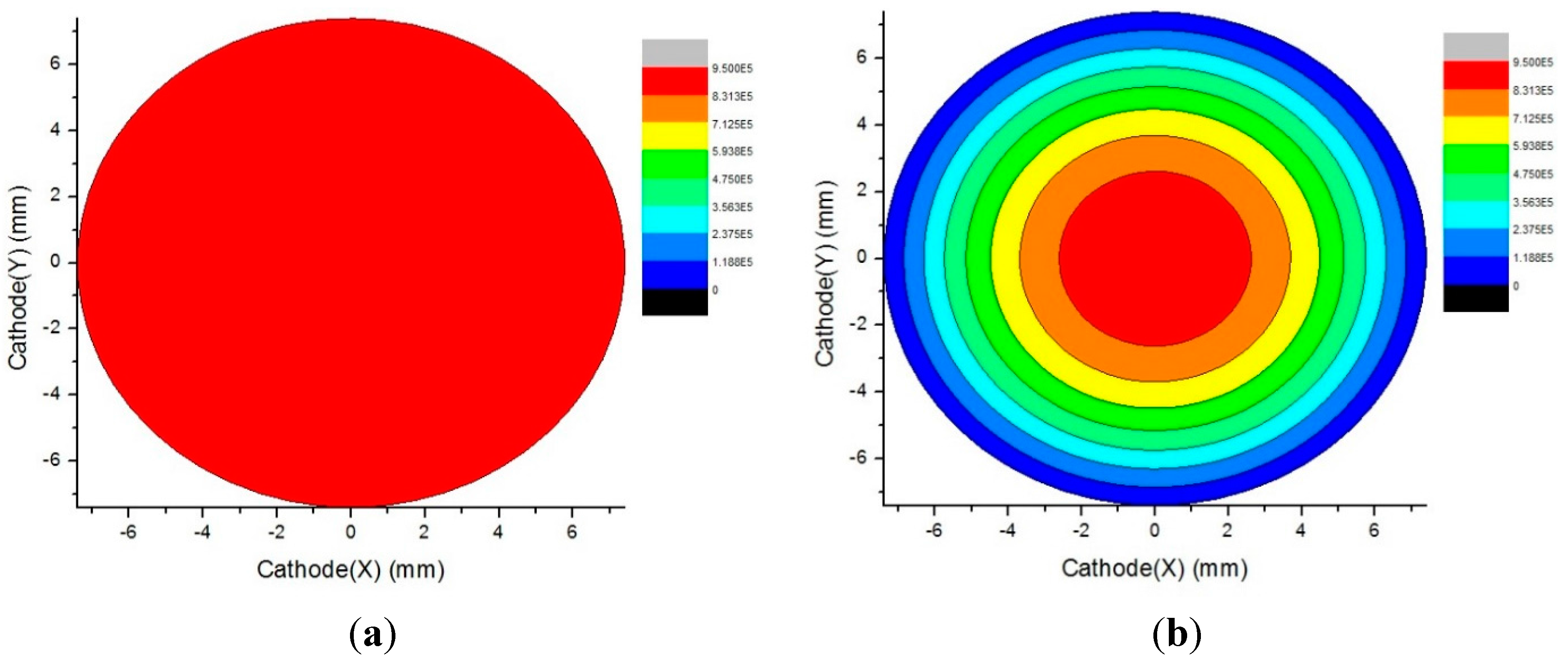
3.2. Characterization of the Synthesized CNCs

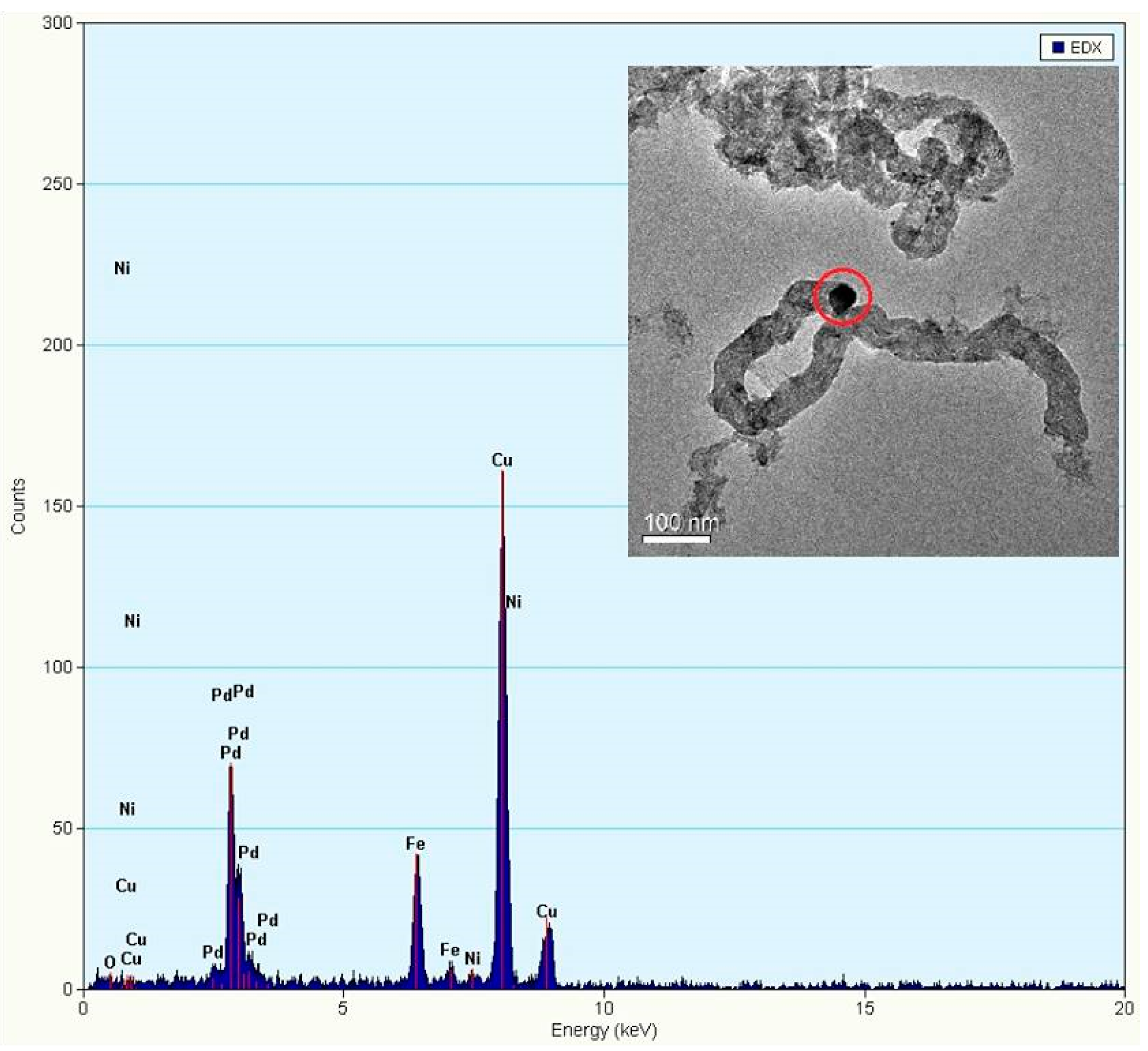
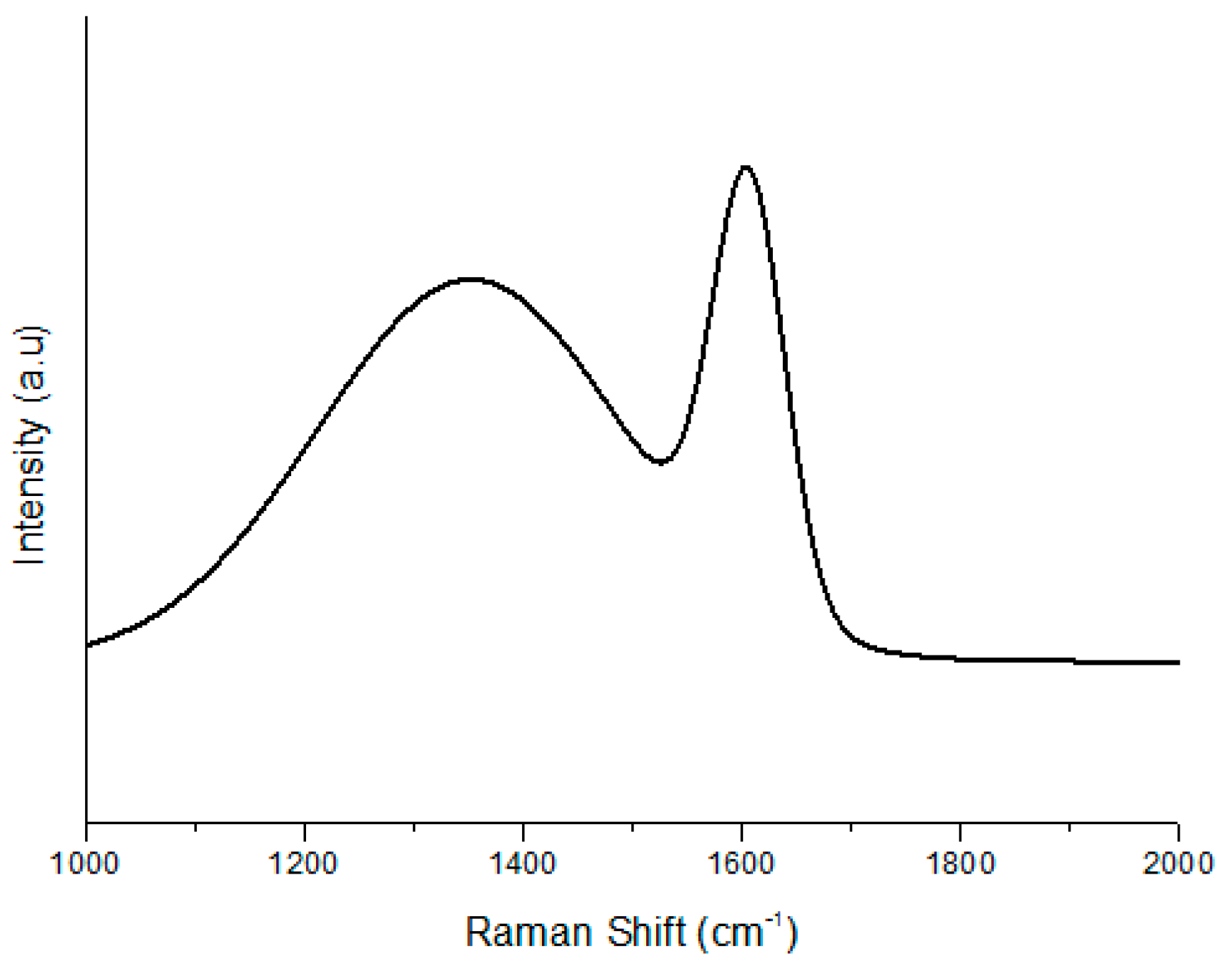
3.3. Test of X-Ray Tube
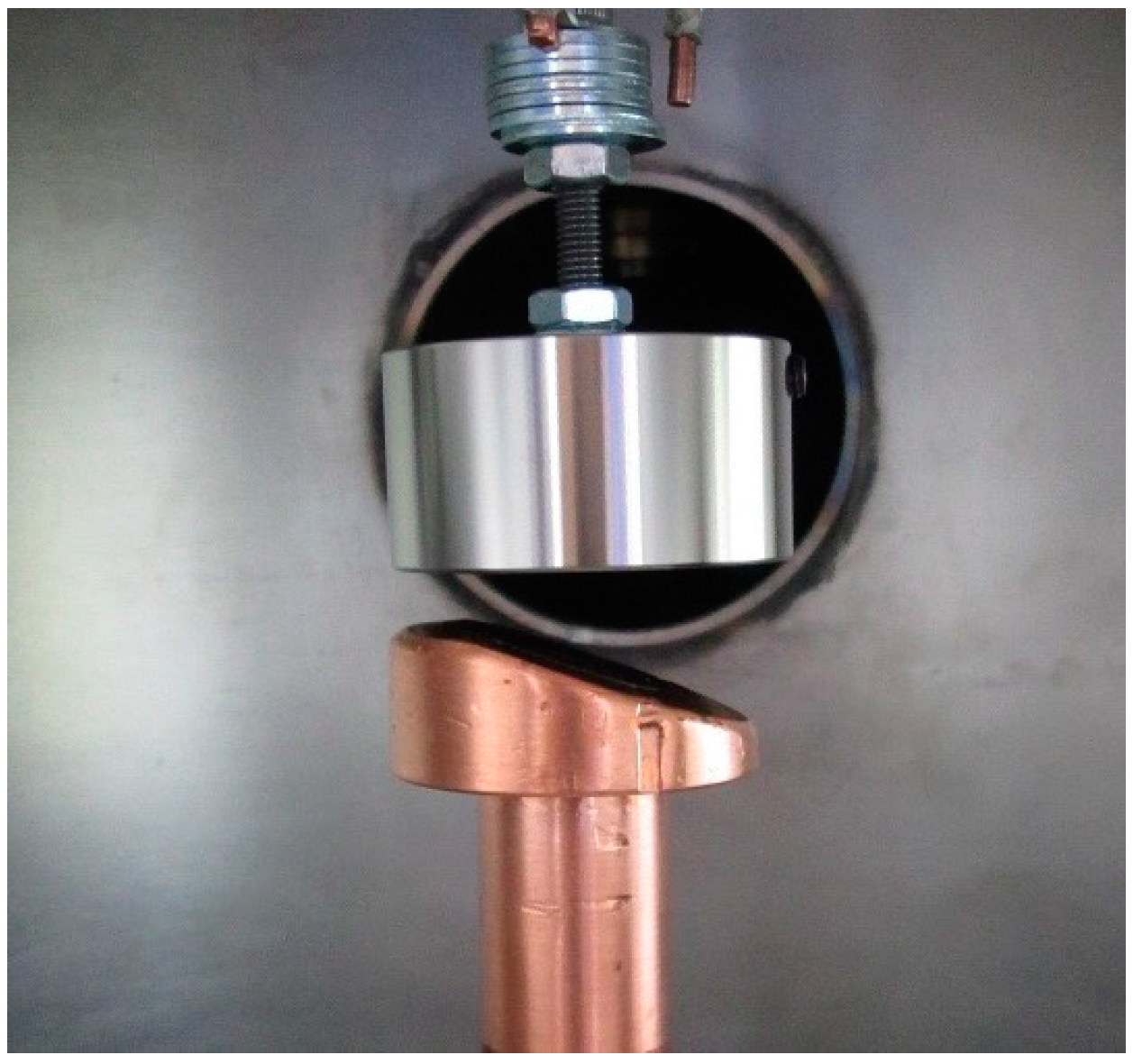
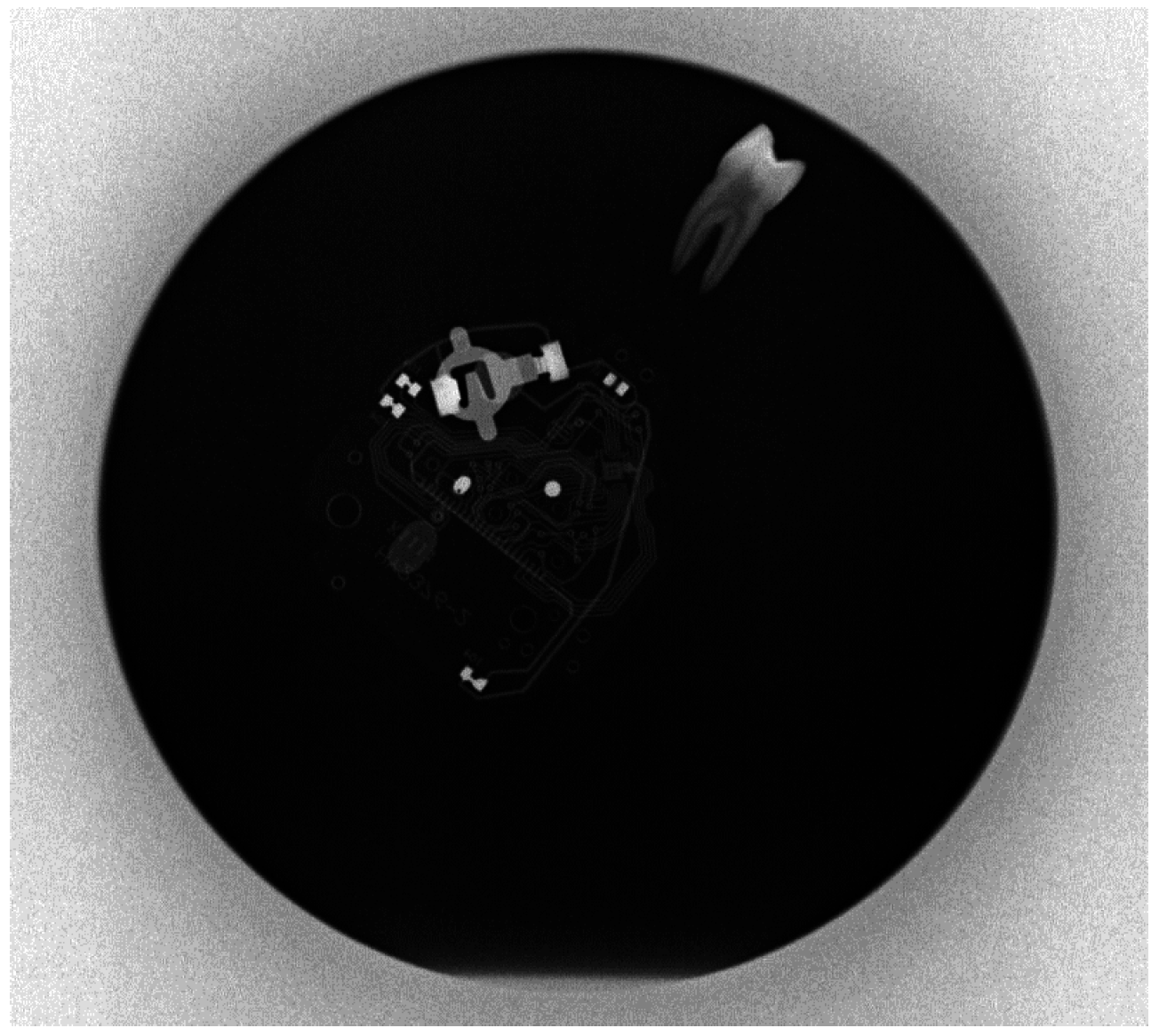
4. Conclusions
Acknowledgments
Author Contributions
Conflicts of Interest
References
- Bushong, S.C. Radiologic Science for Technologist: Physics, Biology, and Protection; Mosby: St. Louis, MO, USA, 1997; p. 5. [Google Scholar]
- Fowler, R.H.; Nordheim, L. Electron emission in intense electric fields. Proc. R. Soc. Lond. A 1928, 119, 173–181. [Google Scholar] [CrossRef]
- Kuznetzov, A.A.; Lee, S.B.; Zhang, M.; Baughman, R.H.; Zakhidov, A.A. Electron field emission from transparent multiwalled carbon nanotube sheets for inverted field emission displays. Carbon 2010, 48, 41–46. [Google Scholar] [CrossRef]
- Zhang, Y.; Deng, S.Z.; Xu, N.S.; Chen, J. Fully sealed carbon nanotube flat-panel light source and its application as thin film transistor-liquid-crystal display backlight. J. Vac. Sci. Technol. B 2008, 26, 1033–1037. [Google Scholar] [CrossRef]
- Bae, N.Y.; Bae, W.M.; Ha, A.N.; Nakamoto, M.; Jang, J.; Park, K.C. Low-voltage driven carbon nanotube field emission lamp. Curr. Appl. Phys. 2011, 11, S86–S89. [Google Scholar] [CrossRef]
- Wang, S.; Calderon, X.; Peng, R.; Schreiber, E.C.; Zhou, O.; Chang, S. A carbon nanotube field emission multipixel X-ray array source for microradiotherapy application. Appl. Phys. Lett. 2011, 98, 213701. [Google Scholar] [CrossRef] [PubMed]
- Whitlock, R.R.; Bell, M.I.; Kerns, D.V.; Kerns, S.; Davidson, J.L.; Kang, W.P. Transmission Cathode for X-ray Production. U.S. Patent 6,333,968, 25 December 2001. [Google Scholar]
- Sugie, H.; Tanemura, M.; Filip, V.; Iwata, K.; Takahashi, K.; Okuyama, F. Carbon nanotubes as electron source in an X-ray tube. Appl. Phys. Lett. 2001, 78, 2578–2580. [Google Scholar] [CrossRef]
- Bandaru, P.R. Electrical properties and applications of carbon nanotube structures. J. Nanosci. Nanotechnol. 2007, 7, 1239–1267. [Google Scholar] [CrossRef] [PubMed]
- Zou, R.; Hu, J.; Song, Y.; Wang, N.; Chen, H.; Chen, H. Carbon nanotubes as field emitter. J. Nanosci. Nanotechnol. 2010, 10, 7876–7896. [Google Scholar] [CrossRef] [PubMed]
- Sarada, Y.; Agarwal, S.; Kar, K.K. A Simple Method for Controlled Growth of Carbon Nanocoils on Metallic Wire by Chemical Vapor Deposition. Nanosci. Nanotechnol. Lett. 2009, 1, 213–217. [Google Scholar] [CrossRef]
- Zhang, M.; Nakayama, Y.; Pan, L. Synthesis of carbon tubule nanocoils in high yield using iron-coated indium tin oxide as catalyst. Jpn. J. Appl. Phys. 2000, 39, 1242–1244. [Google Scholar] [CrossRef]
- Chen, X.; Yang, S.; Motojima, S. Morphology and growth models of circular and flat carbon coils obtained by the catalytic pyrolysis of acetylene. Mater. Lett. 2002, 57, 48–54. [Google Scholar] [CrossRef]
- Hernadi, K.; Fonseca, A.; Nagy, J.B.; Fudala, Á.; Bernaerts, D.; Kiricsi, I. Catalytic production of carbon nanofibers over iron carbide doped with Sn2+. Appl. Catal. A 2002, 228, 103–113. [Google Scholar] [CrossRef]
- Chen, X.; Saito, T.; Kusunoki, M.; Motojima, S. Three-dimensional vapor growth mechanism of carbon microcoils. J. Mater. Res. 1999, 14, 4329–4336. [Google Scholar] [CrossRef]
- Chen, X.; Motojima, S. The growth patterns and morphologies of carbon micro-coils produced by chemical vapor deposition. Carbon 1999, 37, 1817–1823. [Google Scholar] [CrossRef]
- Liu, H.; Saito, Y. Influence of surface roughness on field emission of electrons from carbon nanotube films. J. Nanosci. Nanotechnol. 2010, 10, 3983–3987. [Google Scholar] [CrossRef] [PubMed]
- Zhang, Z.; He, P.; Sun, Z.; Feng, T.; Chen, Y.; Li, H.; Tay, B. Growth and field emission property of coiled carbon nanostructure using copper as catalyst. Appl. Surf. Sci. 2010, 256, 4417–4422. [Google Scholar] [CrossRef]
- Sung, W.Y.; Ok, J.G.; Kim, W.J.; Lee, S.M.; Yeon, S.C.; Lee, H.Y.; Kim, Y.H. Synthesis and field emission characteristics of carbon nanocoils with a high aspect ratio supported by copper micro-tips. Nanotechnology 2010, 18, 245603. [Google Scholar]
- Zhang, J.; Cheng, Y.; Lee, Y.Z.; Gao, B.; Qiu, Q.; Lin, W.L.; Lalush, D.; Lu, J.P.; Zhou, O. A nanotube-based field emission X-ray source for microcomputed Tomography. Rev. Sci. Instrum. 2005, 76, 094301. [Google Scholar] [CrossRef]
- Cheng, Y.; Zhou, O. Electron field emission from carbon nanotubes. Physique 2003, 4, 1021–1033. [Google Scholar] [CrossRef]
- Murphy, E.L.; Good, R.H., Jr. Thermionic Emission, Field Emission, and the Transition Region. Phys. Rev. 1956, 102, 1464–1473. [Google Scholar] [CrossRef]
- Dyke, W.P.; Dolan, W.W. Field emission. Adv. Electron. Electron. Phys. 1956, 8, 89–183. [Google Scholar]
- Gadzuk, J.W.; Plummer, E.W. Field Emission Energy Distribution (FEED). Rev. Mod. Phys. 1973, 45, 487–548. [Google Scholar] [CrossRef]
- Gomer, R. Field emission, field ionization and field desorption. Surface Sci. 1994, 299–300, 129–152. [Google Scholar] [CrossRef]
- De Heer, W.A.; Ugarte, D. Carbon onions produced by heat treatment of carbon soot and their relation to the 217.5 nm interstellar absorption feature. Chem. Phys. Lett. 1993, 207, 480–486. [Google Scholar]
- Fan, S. Self-oriented regular arrays of carbon nanotubes and their field emission properties. Science 1999, 283, 512–514. [Google Scholar] [CrossRef] [PubMed]
- Rinzler, A.G.; Hafner, J.H.; Nikolaev, P.; Nordlander, P.; Colbert, D.T.; Smalley, R.E.; Lou, L.; Kim, S.G.; Tomanek, D. Synthesis of Large Arrays of Well-Aligned Carbon Nanotubes on Glass. Science 1995, 269, 1550–1553. [Google Scholar] [CrossRef] [PubMed]
- De Heer, W.A.; Châtelain, A.; Ugarte, D. A Carbon Nanotube Field-Emission Electron Source. Science 1995, 270, 1179–1180. [Google Scholar] [CrossRef]
- Saito, Y.; Uemura, S. Field emission from carbon nanotubes and its application to electron sources. Carbon 2000, 38, 169–182. [Google Scholar] [CrossRef]
- Bonard, J.M.; Croci, M.; Klinke, C.; Kurt, R.; Noury, O.; Weiss, N. Carbon nanotube films as electron field emitters. Carbon 2002, 40, 1715–1728. [Google Scholar] [CrossRef]
- Huang, J.X.; Chen, J.; Deng, S.Z.; She, J.C.; Xu, N.S. Field-emission fluorescent lamp using carbon nanotubes on a wire-type cold cathode and a reflecting anode. J. Vac. Sci. Technol. B 2008. [Google Scholar] [CrossRef]
- Downs, W.B.; Baker, R.T.K. Novel carbon fiber-carbon filament structures. Carbon 1991, 29, 1173–1179. [Google Scholar] [CrossRef]
- Motojima, S.; Kawaguchi, M.; Nozaki, K.; Iwanaga, H. Preparation of coiled carbon fibers by catalytic pyrolysis of acetylene, and its morphology and extension characteristics. Carbon 1991, 29, 379–385. [Google Scholar] [CrossRef]
- Kawaguchi, M.; Nozaki, K.; Motojima, S.; Iwanaga, H. A growth mechanism of regularly coiled carbon fibers through acetylene pyrolysis. J. Cryst. Growth 1992, 118, 309–313. [Google Scholar] [CrossRef]
- Chen, X.; Motojima, S. Morphologies of carbon micro-coils grown by chemical vapor deposition. J. Mater. Sci. 1999, 34, 5519–5524. [Google Scholar] [CrossRef]
- Chesnokov, V.V.; Zaikovskii, V.I.; Buyanov, R.A. Symmetric twisted carbon filaments formed from butadiene-1,3 on Ni-Cu/MgO-catalyst: Growth regularities and mechanism. J. Mol. Catal. A 2000, 158, 267–270. [Google Scholar] [CrossRef]
- Pu, N.W.; Youh, M.J.; Chung, K.J.; Liu, Y.M.; Ger, M.D. Field emission lamps prepared with dip-coated and nickel electroless plated carbon nanotube cathodes. J. Nanosci. Nanotechnol. 2015, 15, 5093–5098. [Google Scholar] [CrossRef] [PubMed]
- Chung, K.J.; Pu, N.W.; Youh, M.J.; Liu, Y.M.; Ger, M.D.; Cheng, K.; Jiang, J.C. Improvement of Field-Emission-Lamp Characteristics Using Nitrogen-Doped Carbon Nanocoils. Diam. Relat. Mater. 2015, 53, 1–10. [Google Scholar] [CrossRef]
- Chung, K.J.; Pu, N.W.; Youh, M.J.; Liu, Y.M.; Ger, M.D.; Huang, W.K. Improvement of Lighting Uniformity and Phosphor Life in Field Emission Lamps Using Carbon Nano-Coils. J. Nanomater. 2015, in press. [Google Scholar] [CrossRef]
- Chou, Y.P.; Pu, N.W.; Ger, M.D.; Chung, K.J.; Hou, K.H.; Liu, Y.M. Bulb-Shaped Field Emission Lamps Using Carbon Nano-Coil Cathodes. J. Nanosci. Nanotechnol. 2012, 12, 8316–8322. [Google Scholar] [CrossRef] [PubMed]
- Huang, W.K.; Chung, K.J.; Liu, Y.M.; Ger, M.D.; Pu, N.W.; Youh, M.J. Carbon Nanomaterials Synthesized Using a Spray Pyrolysis Method. Vacuum 2015, 118, 94–99. [Google Scholar] [CrossRef]
© 2015 by the authors; licensee MDPI, Basel, Switzerland. This article is an open access article distributed under the terms and conditions of the Creative Commons Attribution license (http://creativecommons.org/licenses/by/4.0/).
Share and Cite
Cheng, K.; Chou, Y.-P.; Youh, M.-J.; Liu, Y.-M.; Ger, M.-D.; Hou, K.-H.; Pu, N.-W. Fabrication and Simulation of Self-Focusing Field Emission X-ray Tubes. Appl. Sci. 2015, 5, 942-954. https://doi.org/10.3390/app5040942
Cheng K, Chou Y-P, Youh M-J, Liu Y-M, Ger M-D, Hou K-H, Pu N-W. Fabrication and Simulation of Self-Focusing Field Emission X-ray Tubes. Applied Sciences. 2015; 5(4):942-954. https://doi.org/10.3390/app5040942
Chicago/Turabian StyleCheng, Kevin, Yi-Ping Chou, Meng-Jey Youh, Yih-Ming Liu, Ming-Der Ger, Kung-Hsu Hou, and Nen-Wen Pu. 2015. "Fabrication and Simulation of Self-Focusing Field Emission X-ray Tubes" Applied Sciences 5, no. 4: 942-954. https://doi.org/10.3390/app5040942
APA StyleCheng, K., Chou, Y.-P., Youh, M.-J., Liu, Y.-M., Ger, M.-D., Hou, K.-H., & Pu, N.-W. (2015). Fabrication and Simulation of Self-Focusing Field Emission X-ray Tubes. Applied Sciences, 5(4), 942-954. https://doi.org/10.3390/app5040942






